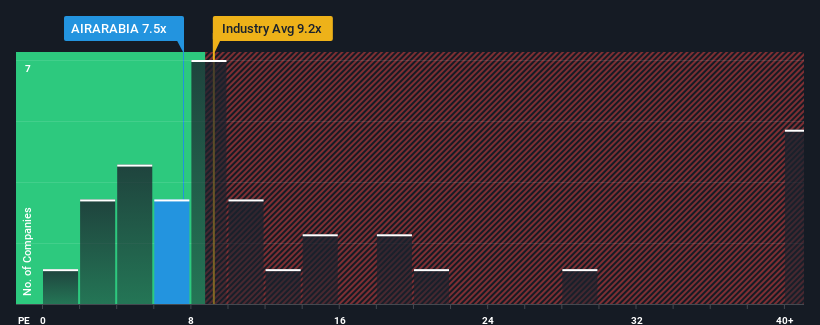- United Arab Emirates
- /
- Airlines
- /
- DFM:AIRARABIA
Air Arabia PJSC (DFM:AIRARABIA) Might Not Be As Mispriced As It Looks

Air Arabia PJSC's (DFM:AIRARABIA) price-to-earnings (or "P/E") ratio of 7.5x might make it look like a buy right now compared to the market in the United Arab Emirates, where around half of the companies have P/E ratios above 13x and even P/E's above 19x are quite common. However, the P/E might be low for a reason and it requires further investigation to determine if it's justified.
Air Arabia PJSC could be doing better as it's been growing earnings less than most other companies lately. The P/E is probably low because investors think this lacklustre earnings performance isn't going to get any better. If you still like the company, you'd be hoping earnings don't get any worse and that you could pick up some stock while it's out of favour.
View our latest analysis for Air Arabia PJSC

What Are Growth Metrics Telling Us About The Low P/E?
Air Arabia PJSC's P/E ratio would be typical for a company that's only expected to deliver limited growth, and importantly, perform worse than the market.
If we review the last year of earnings growth, the company posted a worthy increase of 14%. However, due to its less than impressive performance prior to this period, EPS growth is practically non-existent over the last three years overall. Accordingly, shareholders probably wouldn't have been overly satisfied with the unstable medium-term growth rates.
Turning to the outlook, the next three years should generate growth of 1.8% each year as estimated by the six analysts watching the company. With the market predicted to deliver 3.7% growth per annum, the company is positioned for a comparable earnings result.
With this information, we find it odd that Air Arabia PJSC is trading at a P/E lower than the market. It may be that most investors are not convinced the company can achieve future growth expectations.
The Final Word
Typically, we'd caution against reading too much into price-to-earnings ratios when settling on investment decisions, though it can reveal plenty about what other market participants think about the company.
Our examination of Air Arabia PJSC's analyst forecasts revealed that its market-matching earnings outlook isn't contributing to its P/E as much as we would have predicted. When we see an average earnings outlook with market-like growth, we assume potential risks are what might be placing pressure on the P/E ratio. It appears some are indeed anticipating earnings instability, because these conditions should normally provide more support to the share price.
Having said that, be aware Air Arabia PJSC is showing 1 warning sign in our investment analysis, you should know about.
Of course, you might also be able to find a better stock than Air Arabia PJSC. So you may wish to see this free collection of other companies that have reasonable P/E ratios and have grown earnings strongly.
New: Manage All Your Stock Portfolios in One Place
We've created the ultimate portfolio companion for stock investors, and it's free.
• Connect an unlimited number of Portfolios and see your total in one currency
• Be alerted to new Warning Signs or Risks via email or mobile
• Track the Fair Value of your stocks
Have feedback on this article? Concerned about the content? Get in touch with us directly. Alternatively, email editorial-team (at) simplywallst.com.
This article by Simply Wall St is general in nature. We provide commentary based on historical data and analyst forecasts only using an unbiased methodology and our articles are not intended to be financial advice. It does not constitute a recommendation to buy or sell any stock, and does not take account of your objectives, or your financial situation. We aim to bring you long-term focused analysis driven by fundamental data. Note that our analysis may not factor in the latest price-sensitive company announcements or qualitative material. Simply Wall St has no position in any stocks mentioned.
About DFM:AIRARABIA
Flawless balance sheet established dividend payer.
Similar Companies
Market Insights
Community Narratives




